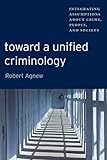Toward a Unified Criminology : Integrating Assumptions about Crime, People and Society / Robert Agnew.
Material type: TextSeries: New Perspectives in Crime, Deviance, and Law ; 1Publisher: New York, NY : New York University Press, [2011]Copyright date: ©2011Description: 1 online resourceContent type:
TextSeries: New Perspectives in Crime, Deviance, and Law ; 1Publisher: New York, NY : New York University Press, [2011]Copyright date: ©2011Description: 1 online resourceContent type: - 9780814705087
- 9780814707906
- 364 23
- online - DeGruyter
| Item type | Current library | Call number | URL | Status | Notes | Barcode | |
|---|---|---|---|---|---|---|---|
 eBook
eBook
|
Biblioteca "Angelicum" Pont. Univ. S.Tommaso d'Aquino Nuvola online | online - DeGruyter (Browse shelf(Opens below)) | Online access | Not for loan (Accesso limitato) | Accesso per gli utenti autorizzati / Access for authorized users | (dgr)9780814707906 |
Frontmatter -- Contents -- Preface -- 1. A Divided Criminology -- 2. The Scope of the Discipline -- 3. Determinism versus Agency -- 4. The Nature of Human Nature -- 5. The Nature of Society -- 6. The Nature of Reality -- 7. A Unified Criminology -- Notes -- Bibliography -- Name Index -- Subject Index -- About the Author
restricted access online access with authorization star
http://purl.org/coar/access_right/c_16ec
Why do people commit crimes? How do we control crime? The theories that criminologists use to answer these questions are built on a number of underlying assumptions, including those about the nature of crime, free will, human nature, and society. These assumptions have a fundamental impact on criminology: they largely determine what criminologists study, the causes they examine, the control strategies they recommend, and how they test their theories and evaluate crime-control strategies. In Toward a Unified Criminology, noted criminologist Robert Agnew provides a critical examination of these assumptions, drawing on a range of research and perspectives to argue that these assumptions are too restrictive, unduly limiting the types of "crime" that are explored, the causes that are considered, and the methods of data collection and analysis that are employed. As such, they undermine our ability to explain and control crime. Agnew then proposes an alternative set of assumptions, drawing heavily on both mainstream and critical theories of criminology, with the goal of laying the foundation for a unified criminology that is better able to explain a broader range of crimes.
Mode of access: Internet via World Wide Web.
In English.
Description based on online resource; title from PDF title page (publisher's Web site, viewed 06. Mrz 2024)


